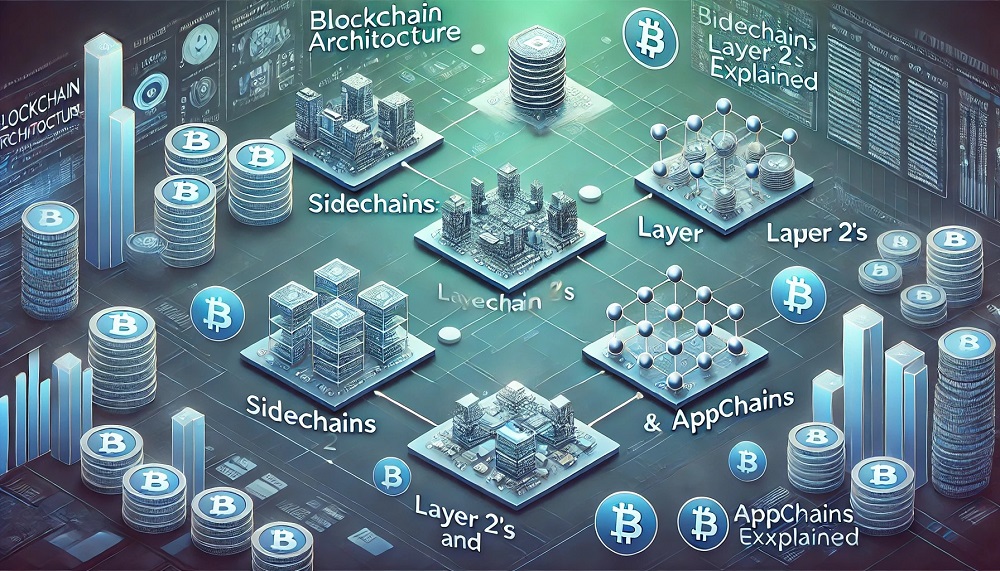Layer 2 solutions (L2s), sidechains, and appchains are off-chain scaling mechanisms that enhance blockchain networks’ efficacy and usability. Each of these solutions is intended to enhance the efficacy of the underlying blockchain by reducing gas fees and increasing transaction speed and scalability.
Blockchain Sidechains Explained
Sidechains are separate blockchains linked by a two-way bridge to a parent or mainnet. As a result, sidechains are a workable option for improving blockchain scalability by enabling asset transfers between the two blockchains.
Every sidechain has its consensus methods and runs independently. The relationship between the two chains is commonly characterized as “parent-child,” meaning that the child network’s resources depend completely on the parent chain. Some examples of Bitcoin sidechains include Liquid Network and Rootstock. Ethereum sidechains: Alpha, Polygon, and Gnosis Chain
What is Layer-2 (L2) Scaling Solutions?
The foundational crypto blockchain is layer-1 (L1), which guarantees data availability, security, and decentralization. L1 blockchains handle transaction processing and uphold network security by consensus algorithms such as proof-of-work (PoW) or proof-of-stake (PoS).
The L1 blockchains of Ethereum and Bitcoin are well-known examples. On the other hand, a layer-2 (L2) network functions as an additional off-chain blockchain or technology built upon the foundational L1 blockchain.
Enhancing the transaction speed and scalability of the L1 blockchain is the main goal of an L2 system. Notably, smart contracts’ operations are based on Layer-2 solutions.
Layer-2 scaling solutions for Bitcoin: Lightning Network for Bitcoin
Ethereum’s layer-2 protocols: Base, Arbitrum, and Optimism
Types of L2 Scaling Solutions
Rollups
Rollups combine and process several transactions off the main chain, then send them to the mainnet for verification. Optimistic rollups use fraud proofs, while zero-knowledge (ZK) rollups use validity proofs.
Ethereum Plasma Chains
This L2 solution uses Merkle trees and smart contracts to create several child chains replicating the Ethereum main chain and improving scalability.
Validium
Validium solutions store transaction data off-chain and ensure blockchain security through validity proofs. Applications that demand frequent, cost-effective transactions benefit from their great scalability and low transaction costs.
State Channels
With State Channels, users can conduct several transactions off-chain and record the final state on the blockchain. This method decreases main chain congestion and transaction fees without sacrificing security.
What is an Application-specific Blockchain (appchain)?
Unlike general-purpose blockchains that allow several apps for different functions, appchains are tailored to a single business need or use case. Appchains can run independently. However, they usually use layer-1 blockchains.
Appchains use layer-1 blockchains for security and networking. No competition for storage and processing gives appchains more flexibility in governance, consensus procedures, and economic models.
Moreover, appchains promote cross-chain interoperability, security, privacy, transaction processing speed, and volume. Examples of appchains include Cosmos Zones, Polkadot Parachains, and Avalanche Subnets.
Differences between Appchains, Sidechains, and Layer 2s
Security
Layer 2 solutions rely on the mainnet security architecture (Layer 1). Appchains also use public blockchains for security. However, sidechains have their security mechanisms that are independent of the mainnet.
Operational Model
Sidechains
Sidechains are autonomous networks with their consensus protocols. Users can operate mainnet nodes using coin-backing nodes and a public block explorer while a two-way bridge connects sidechains to the mainnet.
Layer 2 (L2) Solutions
These solutions manage scaling and individual transactions outside the main chain using an underlying protocol. While they share the Layer-1 blockchain’s load and can add features, the mainnet controls fund exports. Layer-2 solutions are more integrated with mainnet operations and security than sidechains.
Appchains
Appchains usually provide resources to certain programs and do not compete with others.
Public Members
Sidechains: Sidechains are sovereign blockchains that allow public membership.
Layer-2 Solutions: Depending on their architecture, layer-2 solutions can have public members.
Appchains: Appchains are often closed-off infrastructures that do not allow public membership.
Customization
Sidechains
Sidechains have their own rules and protocols, distinct from the mainnet. This independence allows use case adaptation without disrupting the main chain.
Layer-2 Solutions
Layer-2 solutions are less flexible than sidechains. They depend on the mainnet for operations and security. Therefore, Layer-1 blockchain changes can affect them.
Appchains
Although constructed on Layer-1 blockchains, appchains are highly customizable. They are single-purpose and do not compete for resources. Hence, developers have more control over appchain tokenomics, consensus, and governance.
Benefits
Appchains
Appchains offer autonomy in selecting consensus techniques, whether proof-of-stake (PoS) or proof-of-authority (PoA) and are customized for particular use cases.
Sidechains
This allows testing new features and technologies without interfering with the mainchain, thus promoting growth and creativity.
Layer-2 Solutions
By reducing transaction output, Layer-2 solutions ease the strain on the main chain, lowering transaction fees and enhancing overall scalability.
Conclusion
Sidechains, appchains, and Layer 2 solutions offer different scalability, security, and customization benefits. By understanding their operating models and benefits, developers can choose the best method to improve mainchain’s performance and meet application needs.
